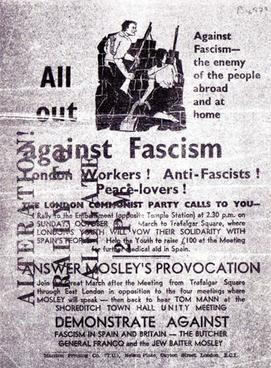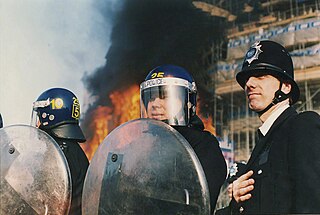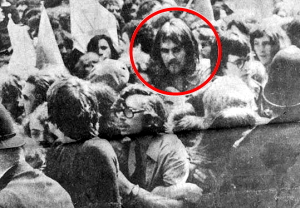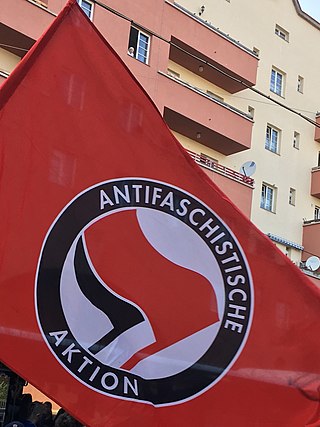
The Battle of Cable Street was a series of clashes that took place at several locations in the East End of London, most notably Cable Street, on Sunday 4 October 1936. It was a clash between the Metropolitan Police, sent to protect a march by members of the British Union of Fascists led by Sir Oswald Mosley, and various anti-fascist demonstrators including local trade unionists, communists, anarchists, British Jews, and socialist groups. The anti-fascist counter-demonstration included both organised and unaffiliated participants.

The National Front (NF) is a far-right, fascist political party in the United Kingdom. It is currently led by Tony Martin. A minor party, it has never had its representatives elected to the British or European Parliaments, although it gained a small number of local councillors through defections and it has had a few of its representatives elected to community councils. Founded in 1967, it reached the height of its electoral support during the mid-1970s, when it was briefly England's fourth-largest party in terms of vote share.
Martin Guy Alan Webster is a British neo-nazi, a former leading figure on the far-right in the United Kingdom. An early member of the National Labour Party, he was John Tyndall's closest ally, and followed him in joining the original British National Party, the National Socialist Movement and the Greater Britain Movement. Webster also spent time in prison for helping to organise a paramilitary organisation, Spearhead, and was convicted under the Public Order Act 1936. Rumours of his homosexuality led to him becoming vilified in far-right circles, and he quietly disappeared from the political scene.

The poll tax riots were a series of riots in British towns and cities during protests against the Community Charge, introduced by the Conservative government of Prime Minister Margaret Thatcher. The largest protest occurred in central London on Saturday 31 March 1990, shortly before the tax was due to come into force in England and Wales.
Squadism was the practice of physical, anti-fascist direct action. The term, often used pejoratively by liberal anti-fascists eschewing violence, originated in the Anti-Nazi League, an anti-fascist campaigning organisation dominated by the heterodox Trotskyist Socialist Workers Party (SWP). The SWP formed "squads", fighting units, in 1977, initially to defend and steward meetings against violent attacks from the fascist National Front. However, other anti-fascist squads emerged separately from the SWP, such as the Sari Squad.

The Order of Flemish Militants – originally the Flemish Militants Organisation – was a Flemish nationalist activist group in Belgium defending far-right interests by propaganda and political action. Established in 1949, they helped found the People's Union in 1954, a Belgian political party. The links between the extremist VMO and the VU lessened as the party moved towards the centre. In later decades the VMO would become linked to neo-Nazism and a series of paramilitary attacks on immigrants and leftists before disappearing by the late 1980s.
Far-right politics in the United Kingdom is a recurring phenomenon in the United Kingdom since the early 20th century, with the formation of Nazi, fascist and antisemitic movements. One of the earliest examples of Fascism in the UK can be found as early as 1923 with the formation of British Fascisti by Rotha Lintorn-Orman. It went on to acquire more explicitly racial connotations, being dominated in the 1960s and 1970s by self-proclaimed white nationalist organisations that opposed non-white and Asian immigration. The idea stems from belief of white supremacy, the belief that white people are superior to all other races and should therefore dominate society. Examples of such groups in the UK are the National Front (NF), the British Movement (BM) and British National Party (BNP), or the British Union of Fascists (BUF). Since the 1980s, the term has mainly been used to describe those groups, such as the English Defence League, who express the wish to preserve what they perceive to be British culture, and those who campaign against the presence of non-indigenous ethnic minorities.

Kevin Gately was a student who died as the result of a head injury received in the Red Lion Square disorders in London while protesting against the National Front, a far-right, fascist political party. It is not known if the injury was caused deliberately or was accidental. He was not a member of any political organisation, and the march at Red Lion Square was his first. He was the first person to die in a public demonstration in Great Britain for at least 55 years.
The Racial Volunteer Force (RVF) is a violent neo-Nazi splinter group of the British neo-Nazi group Combat 18 (C18) with close ties to the far right paramilitary group, British Freedom Fighters. Although originating as a breakaway group, the RVF has since re-established links to C18 whilst maintaining a distinct identity.
Campaign Against Racism and Fascism (CARF) was an anti-racist group and publication based in London which originated in the mid-1970s as an anti-racist/anti-fascist paper published by the federation of Anti-Fascist Committees in Greater London. From 1979 it appeared as a section within the anti-Fascist Searchlight magazine, produced by the CARF Collective based at the Institute of Race Relations, and later still it split with Searchlight to publish as an independent magazine for some years before closing down in 2003. The CARF group then operated as a support group for the IRR's news output.

Anti-Fascist Action (AFA) was a militant anti-fascist organisation, founded in the UK in 1985 by a wide range of anti-racist and anti-fascist organisations.

The Socialist Workers Party (SWP) is a far-left political party in the United Kingdom. Founded as the Socialist Review Group by supporters of Tony Cliff in 1950, it became the International Socialists in 1962 and the SWP in 1977. The party considers itself to be Trotskyist. Cliff and his followers criticised the Soviet Union and its satellites, calling them state capitalist rather than socialist countries.
The Anti-Nazi League (ANL) was an organisation set up in 1977 on the initiative of the Socialist Workers Party (SWP) with sponsorship from some trade unions and the endorsement of a list of prominent people to oppose the rise of far-right groups in the United Kingdom. It was wound down in 1981. It was relaunched in 1992, but merged into Unite Against Fascism in 2003.

Unite Against Fascism (UAF) is a British anti-fascist group.
The London Black Revolutionaries is a revolutionary socialist British political organisation centred in London. The organisation's membership is rumoured to be a mix of Caribbean and South Asian youth, who had been part of an oppositional faction and split of more than 550 members from the Socialist Workers Party (UK) in 2012–13. Its closed membership consists primarily of Black British and British Asian youths, who define themselves as a strictly working-class, grassroots organisation based on anti-racist, anti-fascist, anti-homophobic and anti-sexist principles. Rejecting pacifism, the Black Revolutionaries take a militant approach to their activities, employing direct action as a tactic. The organisation is said to be primarily based in Brixton, South London.

The Battle of Stockton, took place on 10 September 1933 at the Market Cross in the High Street of Stockton-on-Tees, County Durham, England. It was a clash between members of the British Union of Fascists (BUF) and anti-fascist demonstrators from the small local Communist Party and National Unemployed Workers Movement (NUWM).

Post–World War II anti-fascism, including antifa groups, anti-fascist movements and anti-fascist action networks, saw the development of political movements describing themselves as anti-fascist and in opposition to fascism. Those movements have been active in several countries in the aftermath of World War II during the second half of the 20th and early 21st century.

Opposition to the National Front involved various actions taken against the National Front, a far-right political party in the United Kingdom.
The Organisation and structure of the National Front is the management of the National Front, a far-right political party in the United Kingdom.










